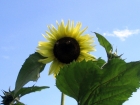Press monitoring
With genes from carnivorous plants, researchers aim to grow hardier crop plants
26.4.2021 | Press monitoring
They won't devour insects with leafy jaws, but with help from carnivorous plant genes, tomatoes, tobacco and other crops could one day better defend themselves from pathogenic fungi and insects. An international team of researchers has received a grant from the Human Frontier Science Program to investigate how carnivory-related genes, such as...
Eliminating resistant bacteria with nanoparticles
23.4.2021 | Press monitoring
Novel nanoparticles developed by researchers at ETH Zurich and Empa detect multi-resistant bacteria hiding in body cells and kill them. The scientists' goal is to develop an antibacterial agent that is effective where conventional antibiotics remain ineffective. In order to track down the germs in their hideouts and eliminate them, a team of...
Researchers grow stem cells to cure glaucoma
21.4.2021 | Press monitoring
A joint research effort carried out by MIPT scientists and Harvard researchers has yielded retinal cells that can integrate into the retina. This is the first successful attempt to transplant ganglion cells (retinal neurons that are destroyed by glaucoma) derived from stem cells in a lab setting. Scientists tested the technology in mice and...
Once-a-week insulin bolstered by results of phase 2 clinical trials
19.4.2021 | Press monitoring
For millions of patients with diabetes, daily insulin injections are a necessary nuisance. A once-a-week shot might be more palatable, and new results from phase 2 clinical trials suggest just such a drug is safe and effective. The drug at the heart of the studies is called icodec, an insulin analog with a half-life of 196 hours – a little over...
Scientists develop eco-friendly pollen sponge to tackle water contaminants
16.4.2021 | Press monitoring
A team of scientists led by Nanyang Technological University, Singapore (NTU Singapore) has created a reusable, biodegradable sponge that can readily soak up oil and other organic solvents from contaminated water sources, making it a promising alternative for tackling marine oil spills. Made of sunflower pollen, the sponge is hydrophobic – it...
Breakthrough in plant protection: RNAi pesticides affect only one pest species
14.4.2021 | Press monitoring
The harmfulness of pesticides to beneficial organisms is one of the most serious concerns in agriculture. Therefore scientists are eagerly looking for new, more environmentally friendly and species-specific solutions. Researchers at the Estonian University of Life Sciences, Ghent and the University of Maastricht took a long step forward in this...
Carbon dots from human hair boost solar cells
12.4.2021 | Press monitoring
QUT researchers have used carbon dots, created from human hair waste sourced from a Brisbane barbershop, to create a kind of "armor" to improve the performance of cutting-edge solar technology. Perovskites solar cells, a relatively new photovoltaic technology, are seen as the best PV candidate to deliver low-cost, highly efficient solar...
Paleopharmaceuticals from Baltic amber might fight drug-resistant infections
9.4.2021 | Press monitoring
For centuries, people in Baltic nations have used ancient amber for medicinal purposes. Even today, infants are given amber necklaces that they chew to relieve teething pain, and people put pulverized amber in elixirs and ointments for its purported anti-inflammatory and anti-infective properties. Now, scientists have pinpointed compounds that...
Brain glue aids regeneration of neurons after traumatic injury
7.4.2021 | Press monitoring
Traumatic brain injuries can have severe and long-lasting repercussions that involve damage to the organ's tissue, cognitive impairments and disability. An implantable "brain glue" material developed at the University of Georgia could offer a way to intervene, by mimicking the supporting structure of brain cells to prevent tissue loss and...
CRISPR-SNP-chip enables amplification-free electronic detection of single point mutations
5.4.2021 | Press monitoring
Keck Graduate Institute (KGI) Assistant Professor and University of California, Berkeley Visiting Scientist Dr. Kiana Aran first introduced the CRISPR-Chip technology in 2019. Now just two years later, she has expanded on its application to develop CRISPR-SNP-Chip, which enables detection of single point mutations without amplification in Sickle...
































